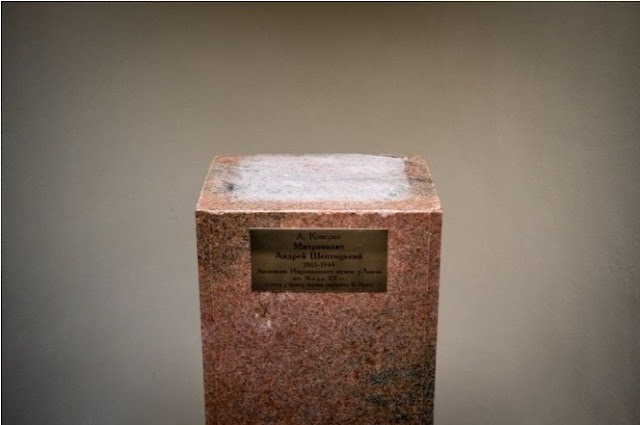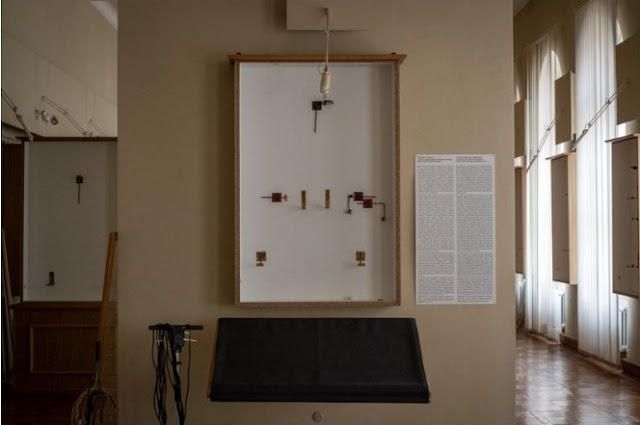In one room of the National Museum of Lviv, a gigantic platform is exposed. In another, sections hang freely from the dividers. Plinths sit void along the halls and wooden beds and cardboard boxes are tossed on the floors. The staff utilized anything that they might get their hands on to pack the historical center's invaluable antiques in a rush.
 |
| Empty Plinths |
In Lviv's exhibitions, historical centers and temples, a tremendous activity is in progress to defend the city's social legacy. Great many fine arts and curios have been painstakingly taken out and taken to secret underground areas, or down to cellar extra spaces.
Ihor Kozhan, the head of the National Museum of Lviv - the biggest craftsmanship gallery in Ukraine - took the BBC on a visit through its presently vacant rooms, which looked like they had been plundered. Environment controlled show cases, normally home to fine arts, symbols and compositions dating as far back as the fourteenth Century, were bare.Nearly all of the 1,500 antiques in plain view has now been taken out from the exhibition hall. The other 97% of the assortment - 180,000 pieces altogether - was at that point away in some structure.
 |
| Climate Controlled Cabinet |
"Everything, everything is gone," Kozhan said.
Notwithstanding administering the activity, Kozhan was stunned by the speed with which the seventeenth century Bohorodchany Iconostasis - a gathering of religions canvases estimating 10m by 8m and one of the historical center's most significant pieces - had been destroyed by his group. It had required a half year to hang, piece by piece, he said, and under six days to pull down from its framework and store away.
Built and covered up seven years starting in 1698, the iconostasis addresses the high watermark of crafted by the symbol painter Yov Kondzelevych. It has been in Lviv beginning around 1924, when the ecclesiastical overseer of the Ukrainian Greek Catholic Church took it back to Ukraine from Poland.
It was destroyed and stowed away from the Nazis in 1939, prohibited from show during the Soviet time, meticulously reestablished in 2006, and presently destroyed again.
There was no arrangement set up for the clearing of the exhibition hall's ancient rarities before the intrusion started fourteen days prior, Kozhan said - not even after Russia started months prior to mass soldiers along Ukraine's lines.
"There was no arrangement in light of the fact that nobody could envision this would occur," he said. "We had no arrangement by any stretch of the imagination - not before the conflict, not even in December. You should comprehend, we didn't really accept that it could work out like this."
Around Lviv, social and strict authorities are running complex activities to wrap up sculptures, close stained glass windows and soul away consecrated antiquities.
In the city's principle square, wellsprings with models of Greek divine beings and goddesses have been enclosed by fire resistant texture and covered with platforms to shield them from falling brick work.
"At first it was a piece tumultuous yet it has become more coordinated," said Liliya Onischenko, the top of Lviv's city committee legacy insurance office.
"We are shooting everything before we remove it and we are capturing every one of the pieces in their secret spots," she said
Onischenko said the need was safeguarding the stained glass windows in the city's chronicled old town, an Unesco world legacy site whose design was worked over hundreds of years by various identities - Poles, Austrians, Hungarians, Germans, Armenians - as the area changed hands.
At the Armenian church building, a valued fifteenth Century wooden figure of Christ on the cross was taken out interestingly since World War Two and taken to confidential, safe spot.
Different relics other than the model have been taken out, the minister, Armen Hakopian said, yet he wouldn't intricate. "What should have been taken out was taken out," he said, with a grin.
The windows at the edge of the 850-year-old Armenian church are plain, on the grounds that the first stained glass was extinguished during the 1940s by German besieging. In any case, above, stained glass stays in the vault and the high pieces of the congregation.
The foundations of Lviv have had the advantage of time to plan. Furthermore, they may yet get away from the brutality. Yet, there are grave feelings of trepidation for the social, strict and engineering treasures in the pieces of Ukraine enduring an onslaught.
There has effectively been critical harm. The stained glass windows and miscreant of the suspicion basilica in Kharkiv were harmed by Russian shelling. Russian soldiers have purportedly obliterated a nineteenth century wooden church in the town of Viazivka in Zhytomyr. Furthermore, an exhibition hall in Ivankiv, north of Kyiv, was bulldozed, annihilating 25 works by the Ukrainian society craftsman Maria Prymachenko.
Ihor Kozhan, the public historical center chief, said he expected that obliterating Ukraine's social texture was important for Russia's objective, and he dreaded enormously for Lviv.
"Assuming a similar harm is done here as in Kharkiv, Mariupol, it would be a horrible misfortune," he said.
"This is a position of authentic memory. The exhibition halls here hold the historical backdrop of the country. They provide us with a comprehension of what our identity was, what our identity is, and who we will be.
"Russia needs to annihilate that."
The occupation of discharging the public gallery was practically finished by Wednesday - a couple of cardboard boxes of compositions were left, close to the entryways, close by a model lying on the floor - one of a few too weighty to even think about moving that will be safeguarded in alternate ways.
The antiques that have been moved underground are on a clock - excessively lengthy there without satisfactory environment control and they would start to corrupt, Kozhan said.
Furthermore, they wouldn't likely not endure an immediate hit, he said, with a long moan, on the grounds that the shelters are not intended to endure strong bombs.
"I really want to believe that we can bring them up soon," he said. "It is challenging for me to be here in these unfilled rooms and foyers. We might have strolled the entire day here together checking our set of experiences and our specialty out."
Requested to assess the absolute worth from the gallery's works, Kozhan declined.
"Obviously there could be no number," he said.
"In the event that these things are annihilated they can't be changed."
